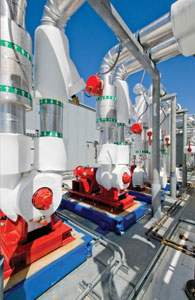
|
| Photo credit: ©istockphoto.com/Craig Cozart |
I was lucky to have had as one of my teachers the late, great Gil Carlson. He was Bell & Gossett’s director of technical services and when he would come to New York City to speak at an ASHRAE event, my old boss would ask me to sit with Gil and keep him company during the day.
This was difficult because Gil was a good listener and by this I mean that he didn’t talk that much, or at least not to me. Now that I’m older than he was then, I realize he probably didn’t have much to say to a dopey kid.
So I would ask him question after question. I might say, “Mr. Carlson, how did you come to realize that circulators in closed systems should always pump away from the compression tank?” And he would answer, “It’s just something I’ve always known.”
And then I was left to come up with the next dopey question. This would go on all day long. It’s the main reason why I can now stand in front of big groups and speak nonstop for hours and hours. Dead air is inspirational.
When the time came to get Gil to the ASHRAE meeting, we’d gather his overhead slides and cigarettes and head out. He smoked like it was his job and walked slowly, but when he got in front of a group of engineers it was magical. He’d sit next to his overhead projector and talk to the slides. But every now and then he’d stand and beam this somewhat maniacal grin from one side of the room to the other. Then he’d take a drag on his cigarette, sit and continue talking to his slides.
I later learned that the managers at Bell & Gossett had sent Gil to a class on public speaking, where he was told that it is important to smile and make eye contact with your audience. This is why Gil turned into a human lighthouse every 15 minutes or so. It was quite unsettling but somehow it worked for him.
Now I’m not an engineer and what I know about engineering came to me by way of books, listening and paying attention, and mostly years after the days I was trying to get Gil to those ASHRAE meetings on time. When I’d sit and listen to his lectures, I was mostly in a state of utter confusion because Gil would launch into this stratospheric ballet of math and charts and graphs.
It was only his visual stuff that stuck with me — the word pictures. And fortunately, there were enough of those to make me want to learn more. I don’t think in numbers; I think in pictures.
Positive pressure
At one point during one of these talks, Gil put up an overhead slide that read NPSH and he asked, “Does anyone know what this acronym stands for?”
An engineer in the front row answered, “Net Positive Suction Head.”
“Well, there’s that,” Gil said. “But it has another meaning. Anyone?” And at this point he once again became a lighthouse. After he sat, he repeated, “Anyone?”
No one answered. Gil lit yet another cigarette, smiled and said, “It stands for Not (he underlined the N with his crayon) Pumping (he underlined the P) So (and so on) Hot!” And then he beamed out another of those wild smiles and the place went nuts.
That’s how I came to understand NPSH. I learned from Gil that there are two kinds: Net Positive Suction Head Available and Net Positive Suction Heat Required. The first is what you find on the job; the second is what the pump manufacturer determines the pump needs.
But now I have to back up a step and ask you to consider the shape of a centrifugal-pump impeller. It has a hole in its end and we call that the “eye” because it acts like the eye of a hurricane but not as nasty. Branching out from the eye we have a bunch of curved vanes and these end at the outer edge of the impeller.
When the impeller spins, it takes the water that’s within the eye and flings it out along those vanes to the edge of the impeller and from there to the outlet of the pump. The instant this happens, a pressure lower than the pressure that’s at the edge of the impeller will appear at the impeller’s eye.
Water in the pump’s suction line will rush in to take the place of the water that’s no longer within the eye of the impeller. Since you can’t compress water, and because the system is completely filled with water, the whole big wheel of water turns.
Now imagine what happens if we clog the pump’s suction line with debris so that when the impeller throws the water from its eye, not enough new water can enter to take the place of the missing water.
Think of a pump serving a cooling tower. Imagine a lot of crap is stuck in the pump’s inlet strainer. Or think of a boiler-feed pump, where the condensate is red hot and close to the boiling point. What if the impeller tosses out that hot water and there’s not enough new water to take its place?



